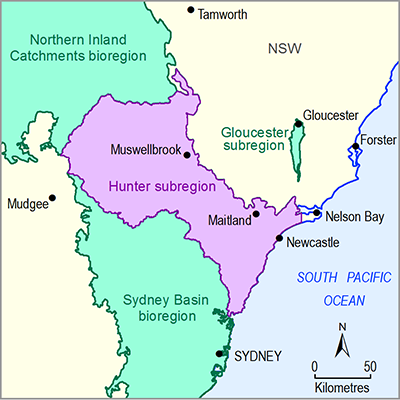- Home
- Assessments
- Bioregional Assessment Program
- Hunter subregion
- 3-4 Impact and risk analysis for the Hunter subregion
- 3.4 Impacts on and risks to landscape classes
- 3.4.2 Landscape classes that are unlikely to be impacted
The majority (3012 km2 or 94%) of the zone of potential hydrological change comprises landscape classes from ‘Non-GDE vegetation’ and ‘Economic land use’ landscape groups (Table 19). The ‘Native vegetation’ landscape class is ruled out from potential impacts, because it is classified in the ‘Non-GDE vegetation’ landscape group and is therefore not considered water dependent for the purposes of BAs. While some landscape classes in the ‘Economic land use’ landscape group are water dependent (e.g. ‘Irrigated agriculture’), impacts on economic assets are not evaluated by landscape class. Potential impacts on economic assets are considered in Section 3.5.
The ‘Highly intermittent or ephemeral’ landscape class in the ‘Riverine’ landscape group is very unlikely to be impacted by drawdown. By definition ephemeral streams flow in response to rainfall, and do not have a baseflow component from connection with groundwater. Ephemeral streams can be impacted through disruption to their natural drainage, for example through creek diversions or alterations due to land surface disturbance, as part of mining operations. The 1228 km of stream network used to define the surface water zone of potential hydrological change includes only those ephemeral streams likely to have disruptions to their natural drainage. A total of 1908 km of streams within the zone are unlikely to be impacted.
The ‘Rainforest’ landscape class within the ‘GDE’ landscape group is very unlikely to be impacted, because if they are dependent on groundwater at all, it is likely to be on local, rather than regional, groundwater sources. The exception are the riparian rainforests of the Wyong River catchment, which, given they occupy the same landscape position as the ‘Forested wetland’ landscape class (i.e. alluvium along perennial streams), are likely to have a dependency on streamflow and alluvial groundwater. They are potentially impacted by changes in groundwater levels and streamflow due to the proposed Wallarah 2 and Mandalong Southern Extension developments, but are not explicitly represented in any of the qualitative or quantitative models developed for the landscape classes.
The ‘Semi-arid woodland’, ‘Heathland’ and ‘Grassy woodland’ landscape classes within the ‘GDE’ landscape group are very unlikely to be impacted because they are located almost exclusively outside the zone of potential hydrological change. Only small areas of the ‘Heathland’ (0.2 km2), ‘Grassy woodland’ (0.2 km2) and ‘Semi-arid woodland’ (<0.1 km2) landscape classes were within the zone. In addition, their use of groundwater tends to be opportunistic or facultative, rather than obligate (see Section 2.7.2.1 of companion product 2.7 for the Hunter subregion (Hosack et al., 2018a)).
The ‘Spring’ landscape class is based on the four assets within the Hunter subregion register of water-dependent assets. None of these four assets intersects the zone; hence, this landscape class is judged very unlikely to be impacted.
The ‘Freshwater wetland’ landscape class within the zone of potential hydrological change is represented entirely by Keith’s (2004) ‘Coastal freshwater lagoons’ vegetation class. A qualitative model was developed for Keith’s ‘Coastal freshwater lagoons’ vegetation class, but experts at the workshop were unable to agree on whether groundwater dependence of these lagoons was regional or local, and whether hydrological changes from underground coal mining higher up in the catchment would affect lagoon hydrology. It was thought that tidal fluctuations influence water levels in the lagoons and that any drawdown would be compensated by the inflow of seawater intrusion, leading to no change in water levels, but potential changes in salinity of the wetland water. Given the lack of certainty about the key driving processes, a quantitative model was not developed for this landscape class (see Section 2.7.2.3 in companion product 2.7 for the Hunter subregion (Hosack et al., 2018a)).
The ‘Lakes’, ‘Lagoons’ and ‘Seagrass’ landscape classes within the ‘Coastal lakes and estuaries’ landscape group are very unlikely to be impacted because the risk to seagrass beds from coal mining is from subsidence, rather than changes in lake inflows and drawdown from mines in the contributing area to the lakes (see Section 2.7.5 in companion product 2.7 for the Hunter subregion (Hosack et al., 2018a)). Subsidence causes base-level lowering of the lake floor which reduces light penetration and can reduce the habitable area for seagrass beds. The establishment of a high water mark subsidence barrier around Lake Macquarie and Tuggerah Lakes, within which maximum vertical subsidence is limited to 20 mm, and the requirement of coal mines to prepare extraction plans, which include details of how subsidence will be managed to minimise impacts, are important regulatory controls intended to avoid or limit impacts to seagrass beds from subsidence (see Section 2.3.4 in companion product 2.3 for the Hunter subregion (Dawes et al., 2018)).
The ‘Creek’ landscape class within the ‘Coastal lakes and estuaries’ landscape group is very unlikely to be impacted because it is upstream of development. The ‘Drowned valleys’ landscape class is very unlikely to be impacted because it does not occur within the zone. The ‘Barrier river’ landscape class within the ‘Coastal lakes and estuaries’ landscape overlaps with the ‘Riverine’ landscape group and impacts on this are evaluated with the ‘Riverine’ landscape group. The ‘Saline wetland’ landscape class within the ‘Coastal lakes and estuaries’ landscape was not evaluated because it was judged that any potential impacts from drawdown due to additional coal resource development would be too fine scale for a BA (see Section 2.7.5 in companion product 2.7 for the Hunter subregion (Hosack et al., 2018a)).

Product Finalisation date
- 3.1 Overview
- 3.2 Methods
- 3.3 Potential hydrological changes
- 3.4 Impacts on and risks to landscape classes
- 3.5 Impacts on and risks to water-dependent assets
- 3.6 Commentary for coal resource developments that are not modelled
- 3.7 Conclusion
- Citation
- Acknowledgements
- Contributors to the Technical Programme
- About this technical product
